Abstract
Acute, isolated loops of proximal and distal jejunum of weanling swine were exposed to either heat stable porcine Escherichia coli enterotoxin, heat labile porcine Escherichia coli enterotoxin, cholera toxin or theophylline. Unidirectional sodium fluxes in response to heat stable in the proximal jejunum were dependent on the length of time that the intestinal mucosae was exposed to the enterotoxin. Net water, sodium and chloride and unidirectional sodium and chloride flux measurements in the proximal jejunum in response to each agent uniformly indicated that net secretion of fluid and electrolytes was the result of increased unidirectional sodium secretion or blood-to-lumen flux and decreased unidirectional chloride absorption or lumen-to-blood flux. In addition heat stable cholera toxin and theophylline but not heat labile decreased unidirectional chloride secretion a small but significant amount in the proximal jejunum.
Sodium and chloride flux measurements in the distal jejunum demonstrated that all four secretory agents could stimulate net secretion of water, sodium and chloride in that region. The response to these secretory agents as measured by sodium and chloride unidirectional flux rates was not similar to changes observed in the proximal jejunum. In the distal small intestine, whereas heat labile cholera toxin and theophylline induced similar qualitative changes in unidirectional sodium and chloride fluxes, that induced by heat stable differed.
Full text
PDF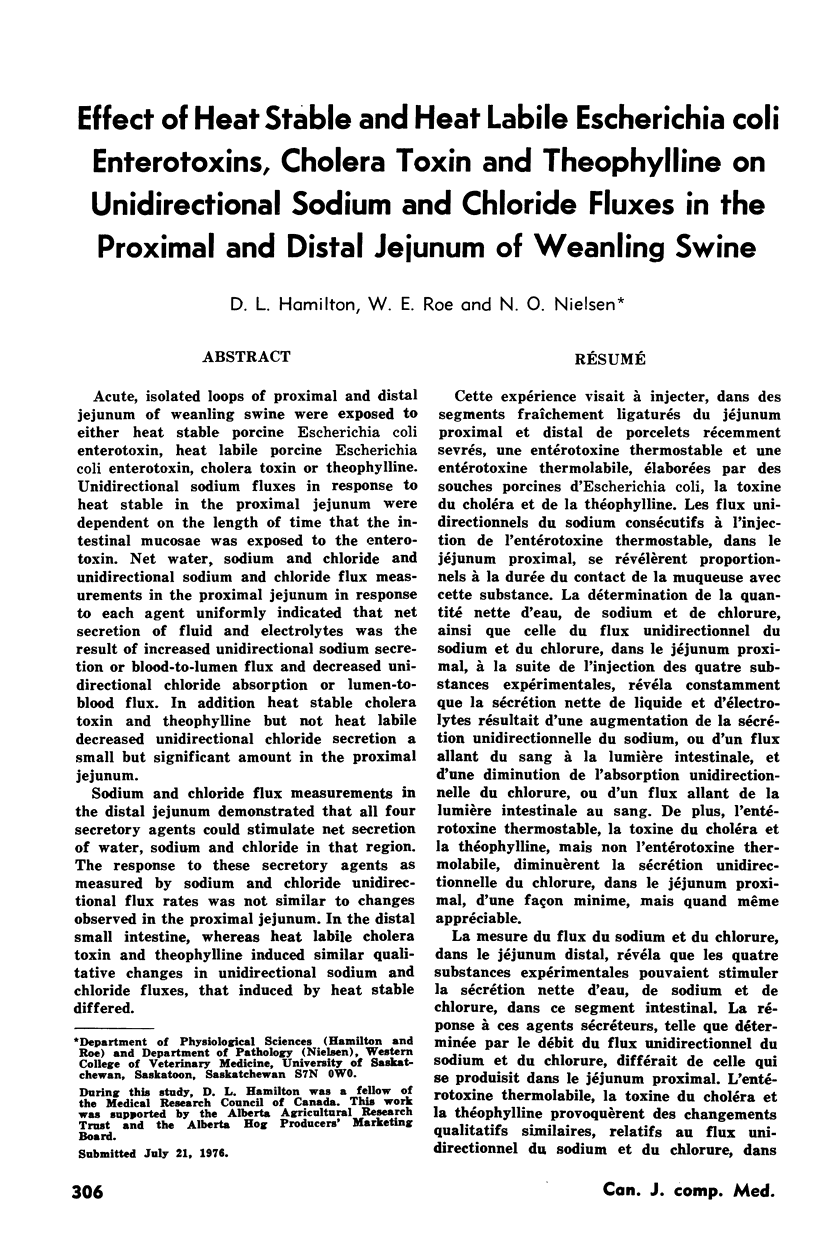
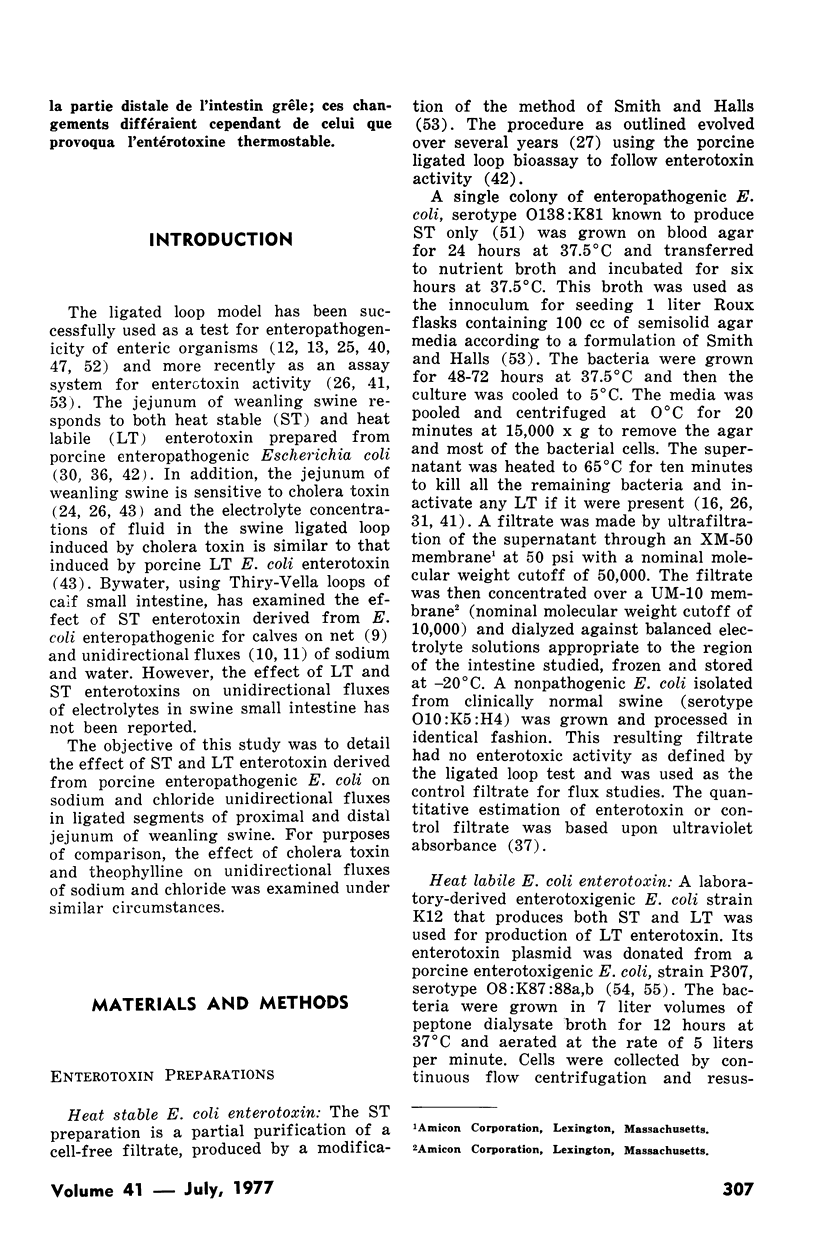
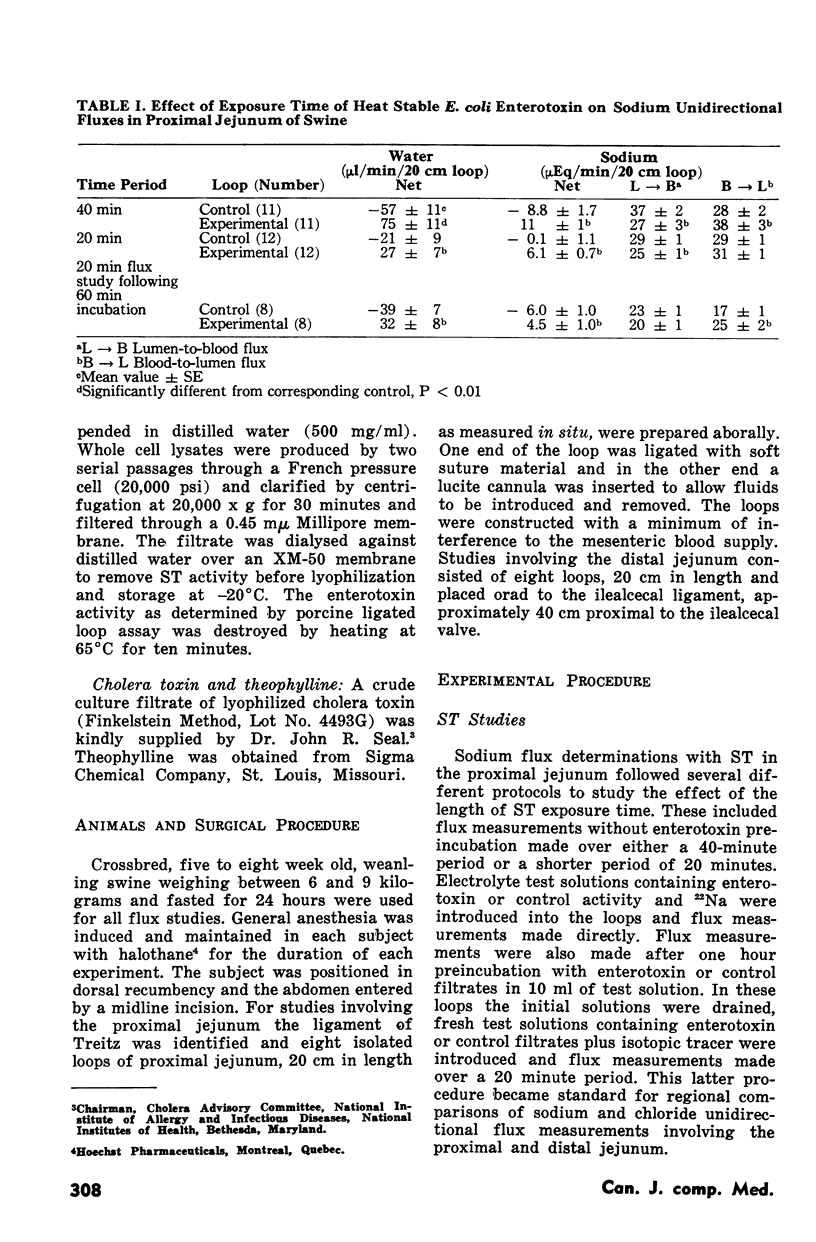
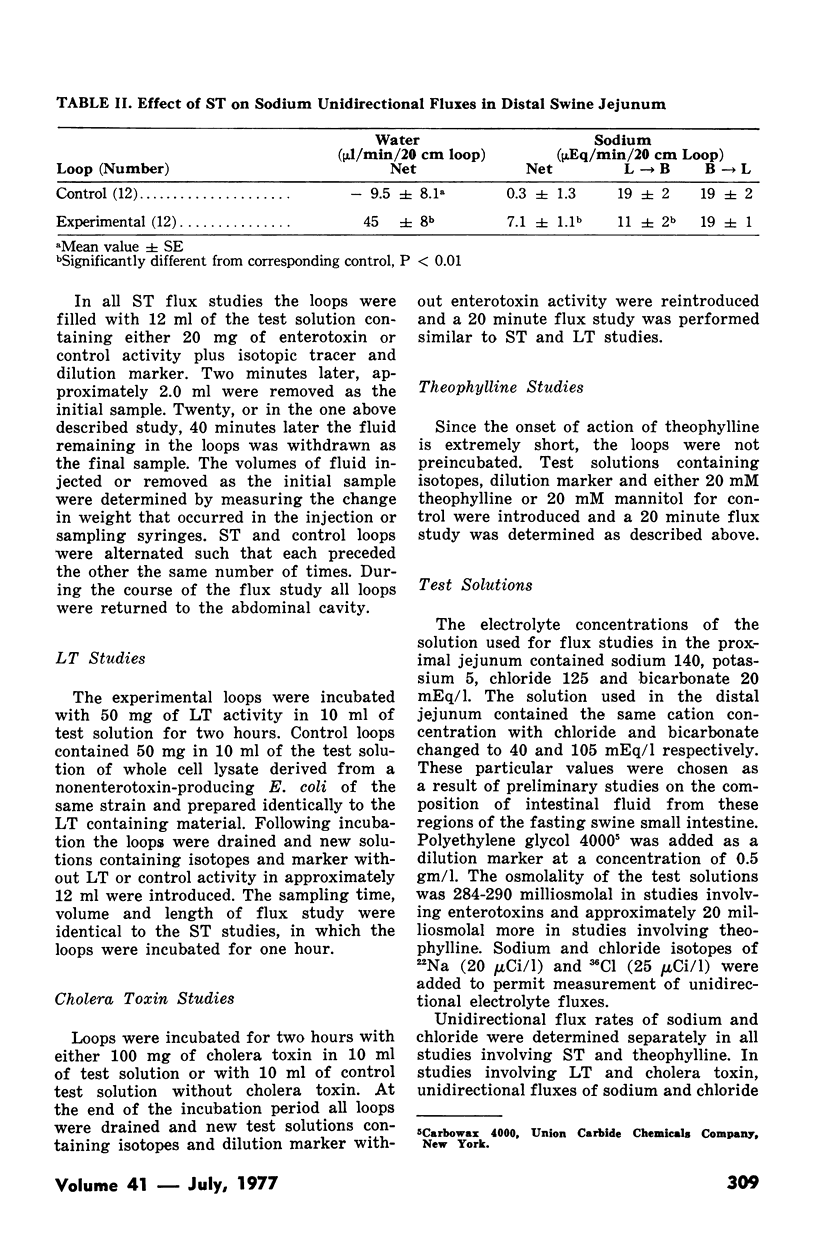
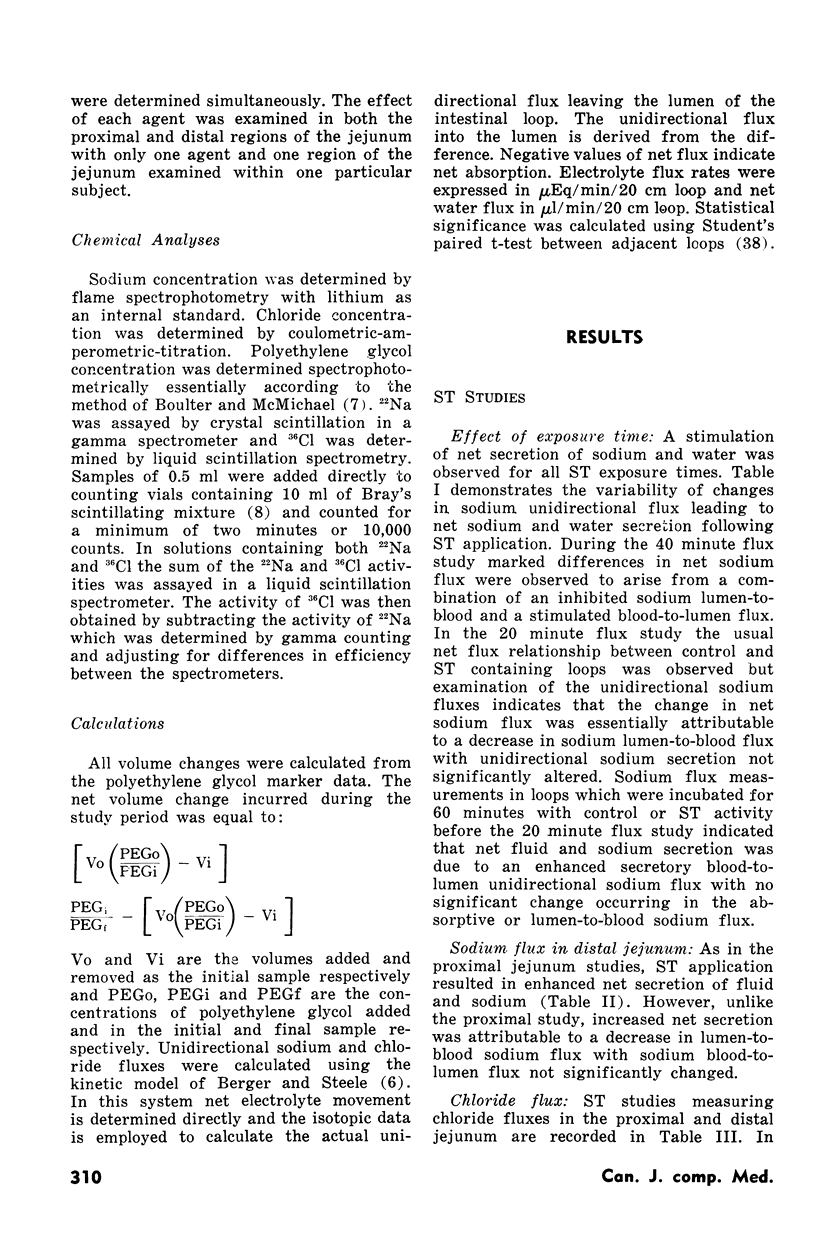
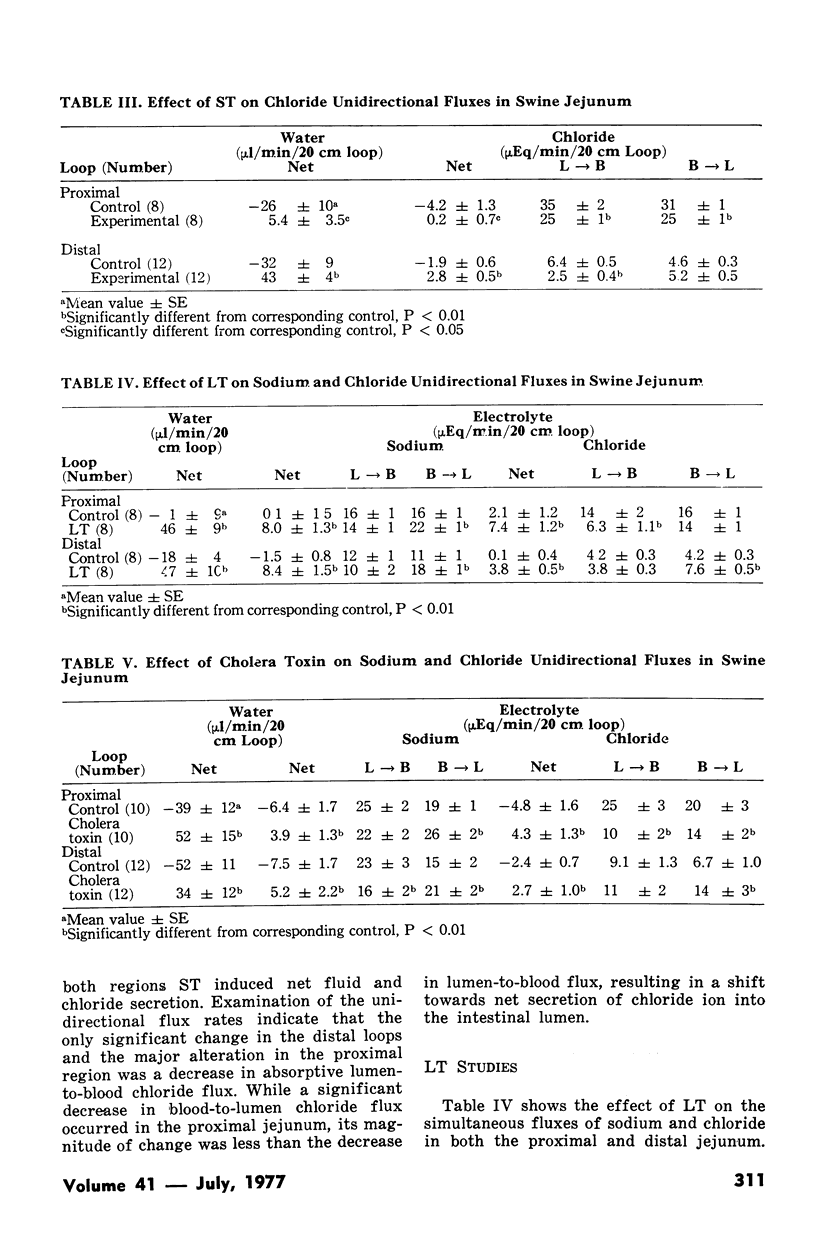
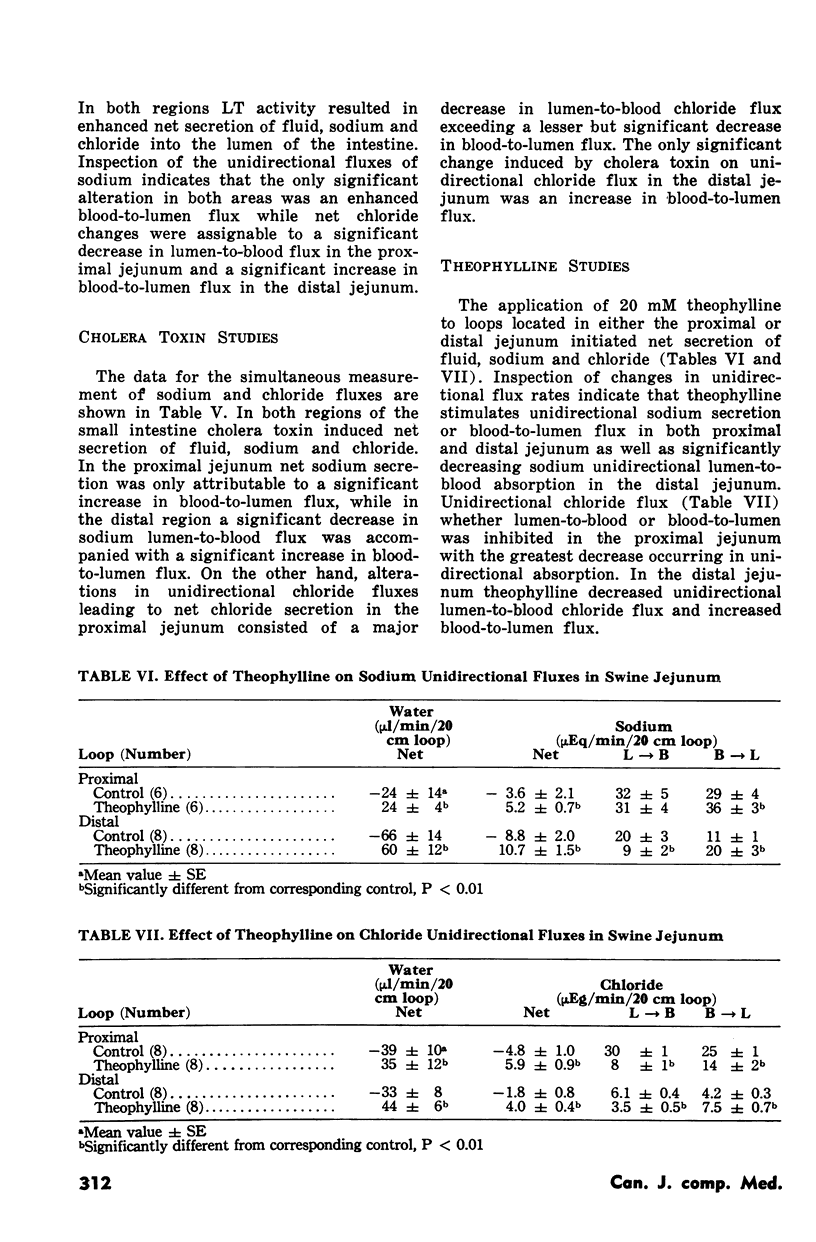

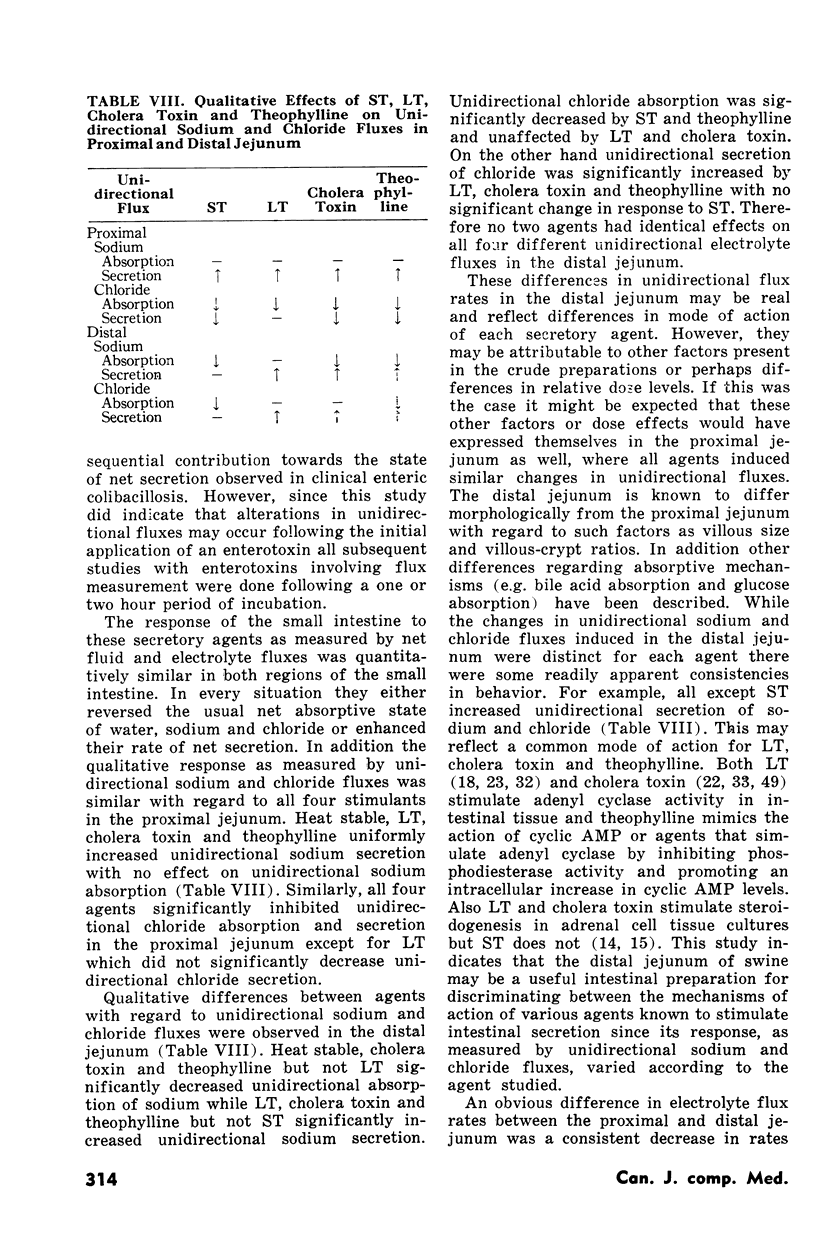
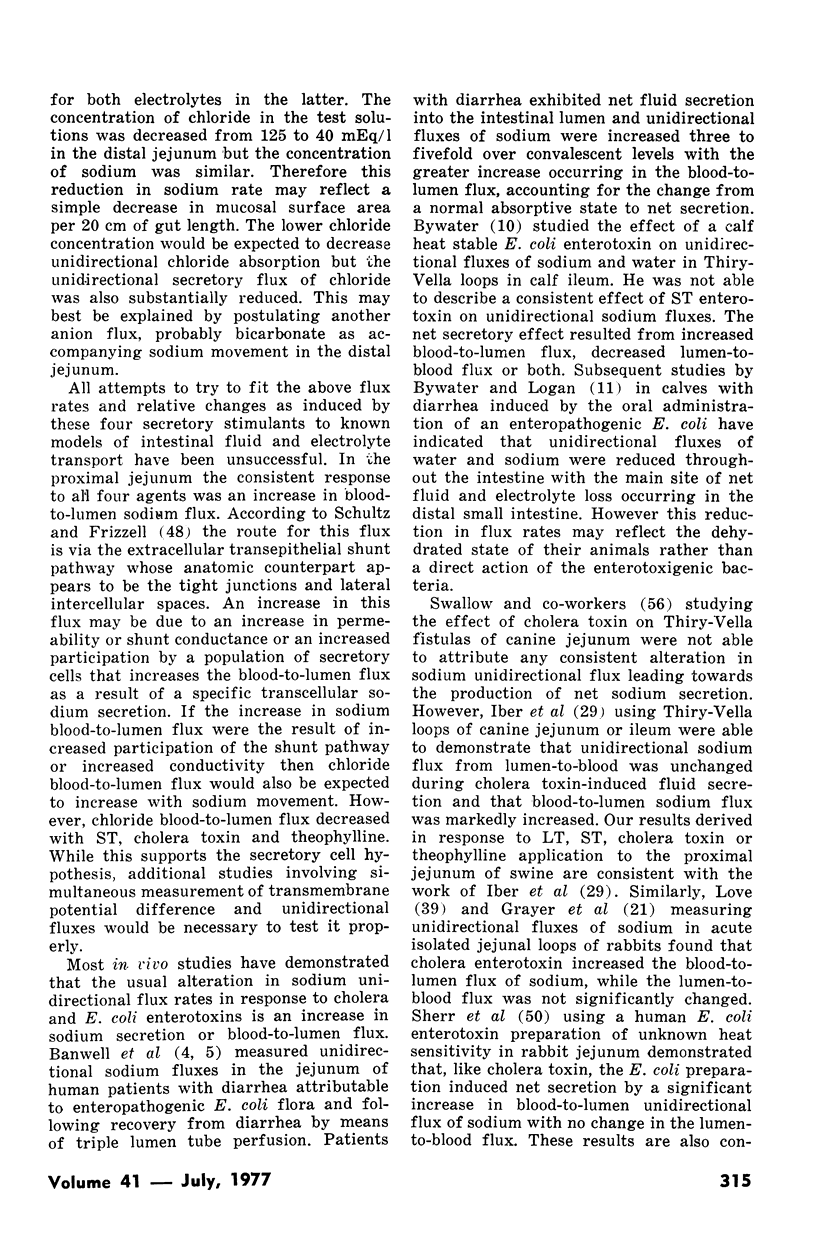
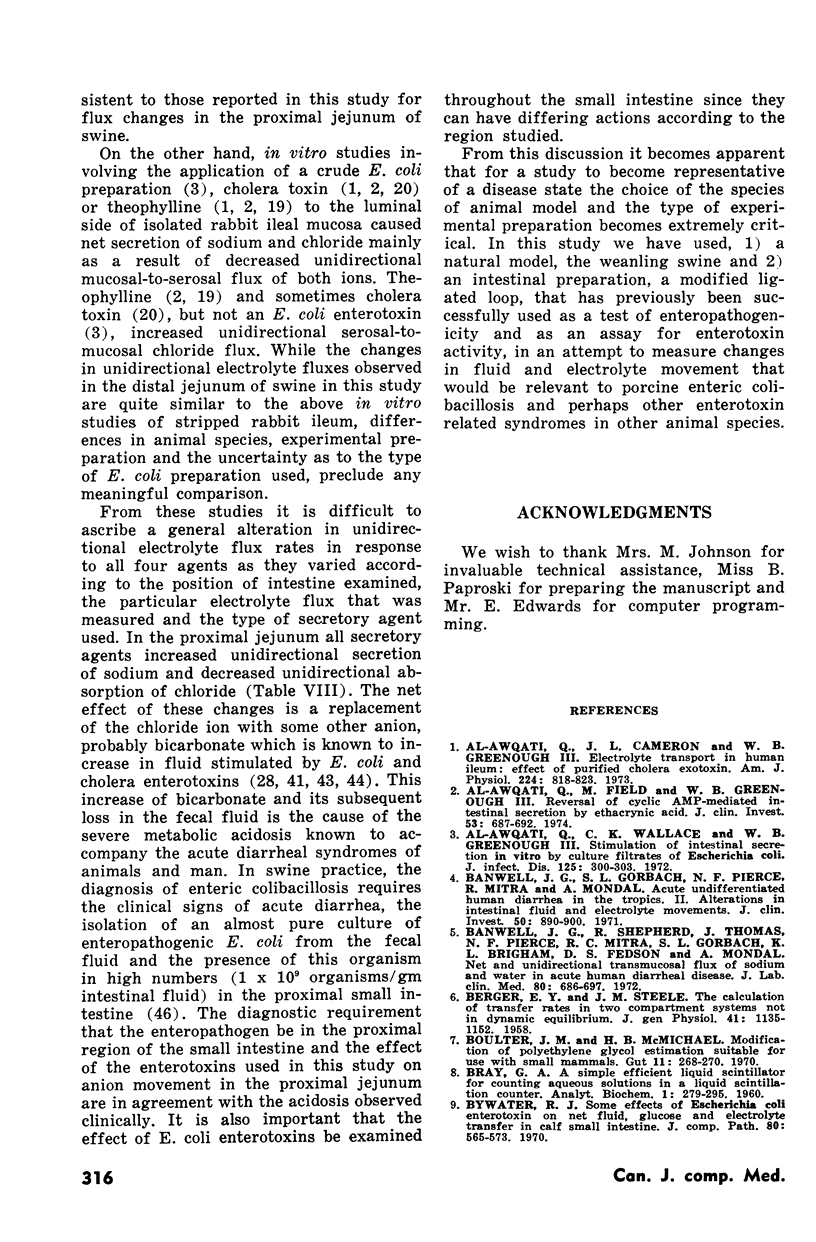
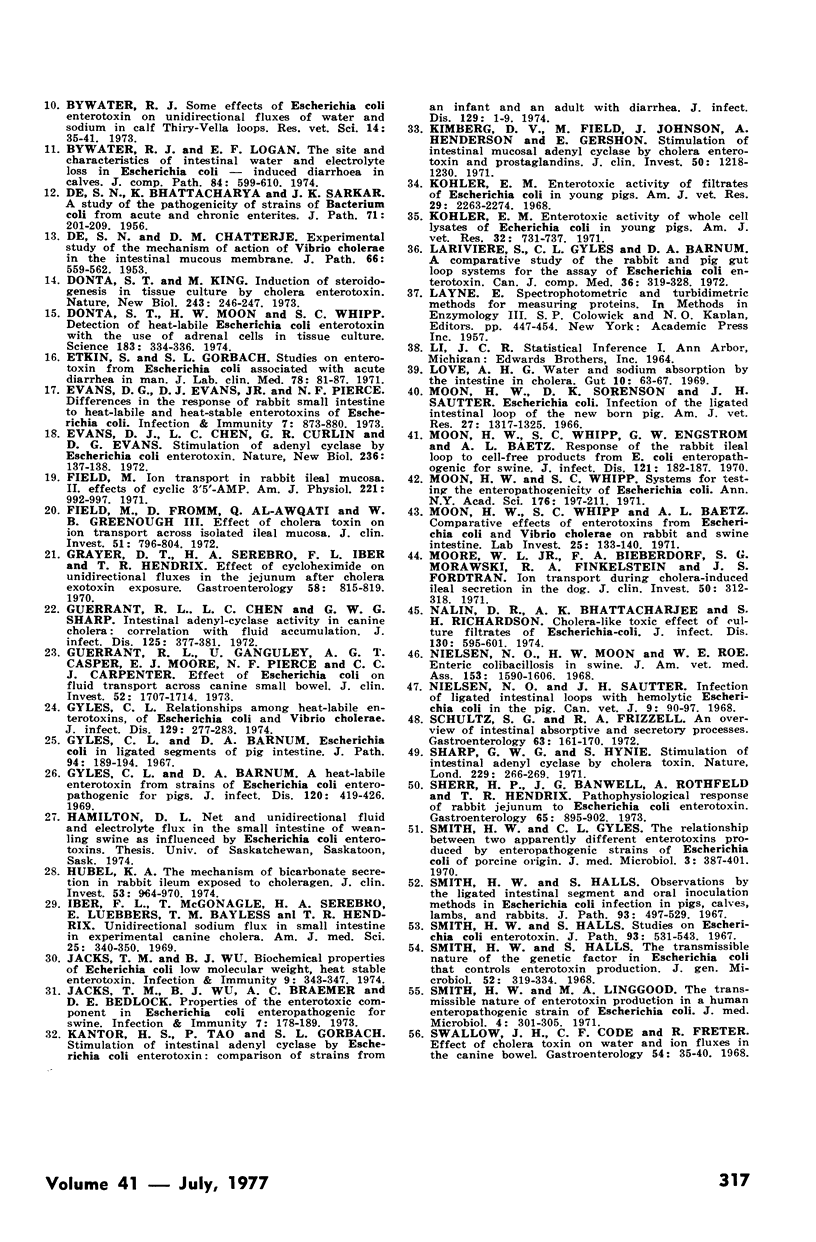
Selected References
These references are in PubMed. This may not be the complete list of references from this article.
- Al-Awqati Q., Wallace C. K., Greenough W. B., 3rd Stimulation of intestinal secretion in vitro by culture filtrates of Escherichia coli. J Infect Dis. 1972 Mar;125(3):300–303. doi: 10.1093/infdis/125.3.300. [DOI] [PubMed] [Google Scholar]
- BERGER E. Y., STEELE J. M. The calculation of transfer rates in two compartment systems not in dynamic equilibrium. J Gen Physiol. 1958 Jul 20;41(6):1135–1152. doi: 10.1085/jgp.41.6.1135. [DOI] [PMC free article] [PubMed] [Google Scholar]
- Banwell J. G., Gorbach S. L., Pierce N. F., Mitra R., Mondal A. Acute undifferentiated human diarrhea in the tropics. II. Alterations in intestinal fluid and electrolyte movements. J Clin Invest. 1971 Apr;50(4):890–900. doi: 10.1172/JCI106561. [DOI] [PMC free article] [PubMed] [Google Scholar]
- Banwell J. G., Shepherd R., Thomas J., Pierce N. F., Mitra R. C., Gorbach S. L., Brigham K. L., Fedson D. S., Mondal A. Net and unidirectional transmucosal flux of sodium and water in acute human diarrheal disease. J Lab Clin Med. 1972 Nov;80(5):686–697. [PubMed] [Google Scholar]
- Boulter J. M., McMichael H. B. Modification of polyethylene glycol estimation suitable for use with small mammals. Gut. 1970 Mar;11(3):268–270. doi: 10.1136/gut.11.3.268. [DOI] [PMC free article] [PubMed] [Google Scholar]
- Bywater R. J., Logan E. F. The site and characteristics of intestinal water and electrolyte loss in Escherichia coli-induced diarrhoea in calves. J Comp Pathol. 1974 Oct;84(4):599–610. doi: 10.1016/0021-9975(74)90051-6. [DOI] [PubMed] [Google Scholar]
- Bywater R. J. Some effects of Escherichia coli enterotoxin on net fluid, glucose and electrolyte transfer in calf small intestine. J Comp Pathol. 1970 Oct;80(4):565–573. doi: 10.1016/0021-9975(70)90054-x. [DOI] [PubMed] [Google Scholar]
- Bywater R. J. Some effects of Escherichia coli enterotoxin on undirectional fluxes of water and sodium in calf Thiry-Vella loops. Res Vet Sci. 1973 Jan;14(1):35–41. [PubMed] [Google Scholar]
- DE S. N., BHATTACHARYA K., SARKAR J. K. A study of the pathogenicity of strains of Bacterium coli from acute and chronic enteritis. J Pathol Bacteriol. 1956 Jan;71(1):201–209. doi: 10.1002/path.1700710126. [DOI] [PubMed] [Google Scholar]
- DE S. N., CHATTERJE D. N. An experimental study of the mechanism of action of Vibriod cholerae on the intestinal mucous membrane. J Pathol Bacteriol. 1953 Oct;66(2):559–562. doi: 10.1002/path.1700660228. [DOI] [PubMed] [Google Scholar]
- Donta S. T., King M., Sloper K. Induction of steroidogenesis in tissue culture by cholera enterotoxin. Nat New Biol. 1973 Jun 20;243(129):246–247. doi: 10.1038/newbio243246a0. [DOI] [PubMed] [Google Scholar]
- Donta S. T., Moon H. W., Whipp S. C. Detection of heat-labile Escherichia coli enterotoxin with the use of adrenal cells in tissue culture. Science. 1974 Jan 25;183(4122):334–336. doi: 10.1126/science.183.4122.334. [DOI] [PubMed] [Google Scholar]
- Etkin S., Gorbach S. L. Studies on enterotoxin from Escherichia coli associated with acute diarrhea in man. J Lab Clin Med. 1971 Jul;78(1):81–87. [PubMed] [Google Scholar]
- Evans D. G., Evans D. J., Jr, Pierce N. F. Differences in the response of rabbit small intestine to heat-labile and heat-stable enterotoxins of Escherichia coli. Infect Immun. 1973 Jun;7(6):873–880. doi: 10.1128/iai.7.6.873-880.1973. [DOI] [PMC free article] [PubMed] [Google Scholar]
- Evans D. J., Jr, Chen L. C., Curlin G. T., Evans D. G. Stimulation of adenyl cyclase by Escherichia coli enterotoxin. Nat New Biol. 1972 Apr 5;236(66):137–138. doi: 10.1038/newbio236137a0. [DOI] [PubMed] [Google Scholar]
- Field M., Fromm D., al-Awqati Q., Greenough W. B., 3rd Effect of cholera enterotoxin on ion transport across isolated ileal mucosa. J Clin Invest. 1972 Apr;51(4):796–804. doi: 10.1172/JCI106874. [DOI] [PMC free article] [PubMed] [Google Scholar]
- Field M. Ion transport in rabbit ileal mucosa. II. Effects of cyclic 3', 5'-AMP. Am J Physiol. 1971 Oct;221(4):992–997. doi: 10.1152/ajplegacy.1971.221.4.992. [DOI] [PubMed] [Google Scholar]
- Grayer D. T., Serebro H. A., Iber F. L., Hendrix T. R. Effect of cycloheximide on unidirectional sodium fluxes in the jejunum after cholera exotoxin exposure. Gastroenterology. 1970 Jun;58(6):815–819. [PubMed] [Google Scholar]
- Guerrant R. L., Chen L. C., Sharp G. W. Intestinal adenyl-cyclase activity in canine cholera: correlation with fluid accumulation. J Infect Dis. 1972 Apr;125(4):377–381. doi: 10.1093/infdis/125.4.377. [DOI] [PubMed] [Google Scholar]
- Guerrant R. L., Ganguly U., Casper A. G., Moore E. J., Pierce N. F., Carpenter C. C. Effect of Escherichia coli on fluid transport across canine small bowel. Mechanism and time-course with enterotoxin and whole bacterial cells. J Clin Invest. 1973 Jul;52(7):1707–1714. doi: 10.1172/JCI107352. [DOI] [PMC free article] [PubMed] [Google Scholar]
- Gyles C. L., Barnum D. A. A heat-labile enterotoxin from strains of Eschericha coli enteropathogenic for pigs. J Infect Dis. 1969 Oct;120(4):419–426. doi: 10.1093/infdis/120.4.419. [DOI] [PubMed] [Google Scholar]
- Gyles C. L., Barnum D. A. Escherichia coli in ligated segments of pig intestine. J Pathol Bacteriol. 1967 Jul;94(1):189–194. doi: 10.1002/path.1700940124. [DOI] [PubMed] [Google Scholar]
- Gyles C. L. Relationships among heat-labile enterotoxins of Escherichia coli and Vibrio cholerae. J Infect Dis. 1974 Mar;129(3):277–283. doi: 10.1093/infdis/129.3.277. [DOI] [PubMed] [Google Scholar]
- Hubel K. A. The mechanism of bicarbonate secretion in rabbit ileum exposed to choleragen. J Clin Invest. 1974 Apr;53(4):964–970. doi: 10.1172/JCI107662. [DOI] [PMC free article] [PubMed] [Google Scholar]
- Iber F. L., McGonagle T., Serebro H. A., Luebbers E., Bayless T. M., Hendrix T. R. Unidirectional sodium flux in small intestine in experimental canine cholera. Am J Med Sci. 1969 Nov;258(5):340–350. doi: 10.1097/00000441-196911000-00005. [DOI] [PubMed] [Google Scholar]
- Jacks T. M., Wu B. J. Biochemical properties of Escherichia coli low-molecular-weight, heat-stable enterotoxin. Infect Immun. 1974 Feb;9(2):342–347. doi: 10.1128/iai.9.2.342-347.1974. [DOI] [PMC free article] [PubMed] [Google Scholar]
- Jacks T. M., Wu B. J., Braemer A. C., Bidlack D. E. Properties of the enterotoxic component in Escherichia coli enteropathogenic for swine. Infect Immun. 1973 Feb;7(2):178–189. doi: 10.1128/iai.7.2.178-189.1973. [DOI] [PMC free article] [PubMed] [Google Scholar]
- Kantor H. S., Tao P., Gorbach S. L. Stimulation of intestinal adenyl cyclase by Escherichia coli enterotoxin: comparison of strains from an infant and an adult with diarrhea. J Infect Dis. 1974 Jan;129(1):1–9. doi: 10.1093/infdis/129.1.1. [DOI] [PubMed] [Google Scholar]
- Kimberg D. V., Field M., Johnson J., Henderson A., Gershon E. Stimulation of intestinal mucosal adenyl cyclase by cholera enterotoxin and prostaglandins. J Clin Invest. 1971 Jun;50(6):1218–1230. doi: 10.1172/JCI106599. [DOI] [PMC free article] [PubMed] [Google Scholar]
- Kohler E. M. Enterotoxic activity of filtrates of escherichia coli in young pigs. Am J Vet Res. 1968 Dec;29(12):2263–2274. [PubMed] [Google Scholar]
- Kohler E. M. Enterotoxic activity of whole cell lysates of Escherichia coli in young pigs. Am J Vet Res. 1971 May;32(5):731–737. [PubMed] [Google Scholar]
- Larivière S., Gyles C. L., Barnum D. A. A comparative study of the rabbit and pig gut loop systems for the assay of Escherichia coli enterotoxin. Can J Comp Med. 1972 Oct;36(4):319–328. [PMC free article] [PubMed] [Google Scholar]
- Love A. H. Water and sodium absorption by the intestine in cholera. Gut. 1969 Jan;10(1):63–67. doi: 10.1136/gut.10.1.63. [DOI] [PMC free article] [PubMed] [Google Scholar]
- Moon H. W., Whipp S. C., Baetz A. L. Comparative effects of enterotoxins from Escherichia coli and Vibrio cholerae on rabbit and swine small intestine. Lab Invest. 1971 Aug;25(2):133–140. [PubMed] [Google Scholar]
- Moon H. W., Whipp S. C., Engstrom G. W., Baetz A. L. Response of the rabbit ileal loop to cell-free products from Escherichia coli enteropathogenic for swine. J Infect Dis. 1970 Feb;121(2):182–187. doi: 10.1093/infdis/121.2.182. [DOI] [PubMed] [Google Scholar]
- Moore W. L., Jr, Bieberdorf F. A., Morawski S. G., Finkelstein R. A., Fordtran J. S. Ion transport during cholera-induced ileal secretion in the dog. J Clin Invest. 1971 Feb;50(2):312–318. doi: 10.1172/JCI106496. [DOI] [PMC free article] [PubMed] [Google Scholar]
- Nalin D. R., Bhattacharjee A. K., Richardson S. H. Cholera-like toxic effect of culture filtrates of Escherichia coli. J Infect Dis. 1974 Dec;130(6):595–607. doi: 10.1093/infdis/130.6.595. [DOI] [PubMed] [Google Scholar]
- Nielsen N. O., Moon H. W., Roe W. E. Enteric colibacillosis in swine. J Am Vet Med Assoc. 1968 Dec 15;153(12):1590–1606. [PubMed] [Google Scholar]
- Nielsen N. O., Sautter J. H. Infection of ligated intestinal loops with hemolytic Escherichia coli in the pig. Can Vet J. 1968 Apr;9(4):90–97. [PMC free article] [PubMed] [Google Scholar]
- Schultz S. G., Frizzell R. A. An overview of intestinal absorptive and secretory processes. Gastroenterology. 1972 Jul;63(1):161–170. [PubMed] [Google Scholar]
- Sharp G. W., Hynie S. Stimulation of intestinal adenyl cyclase by cholera toxin. Nature. 1971 Jan 22;229(5282):266–269. doi: 10.1038/229266a0. [DOI] [PubMed] [Google Scholar]
- Sherr H. P., Banwell J. G., Rothfeld A., Hendrix T. R. Pathophysiological response of rabbit jejunum to Escherichia coli enterotoxin. Gastroenterology. 1973 Dec;65(6):895–902. [PubMed] [Google Scholar]
- Smith H. W., Gyles C. L. The relationship between two apparently different enterotoxins produced by enteropathogenic strains of Escherichia coli of porcine origin. J Med Microbiol. 1970 Aug;3(3):387–401. doi: 10.1099/00222615-3-3-387. [DOI] [PubMed] [Google Scholar]
- Smith H. W., Halls S. Observations by the ligated intestinal segment and oral inoculation methods on Escherichia coli infections in pigs, calves, lambs and rabbits. J Pathol Bacteriol. 1967 Apr;93(2):499–529. doi: 10.1002/path.1700930211. [DOI] [PubMed] [Google Scholar]
- Smith H. W., Halls S. Studies on Escherichia coli enterotoxin. J Pathol Bacteriol. 1967 Apr;93(2):531–543. doi: 10.1002/path.1700930212. [DOI] [PubMed] [Google Scholar]
- Smith H. W., Linggood M. A. The transmissible nature of enterotoxin production in a human enteropathogenic strain of Escherichia coli. J Med Microbiol. 1971 Aug;4(3):301–305. doi: 10.1099/00222615-4-3-301. [DOI] [PubMed] [Google Scholar]
- Swallow J. H., Code C. F., Freter R. Effect of cholera toxin on water and ion fluxes in the canine bowel. Gastroenterology. 1968 Jan;54(1):35–40. [PubMed] [Google Scholar]
- al-Awqati Q., Field M., Greenough W. B., 3rd Reversal of cyclic AMP-mediated intestinal secretion by ethacrynic acid. J Clin Invest. 1974 Mar;53(3):687–692. doi: 10.1172/JCI107606. [DOI] [PMC free article] [PubMed] [Google Scholar]
- el-Awqati Q., Cameron J. L., Greenough W. B., 3rd Electrolyte transport in human ileum: effect of purified cholera exotoxin. Am J Physiol. 1973 Apr;224(4):818–823. doi: 10.1152/ajplegacy.1973.224.4.818. [DOI] [PubMed] [Google Scholar]


